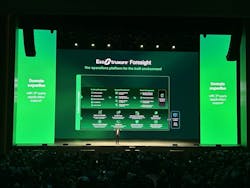Vegas Triple Play: Schneider Electric Starts Innovation Summit Announcing HQ Move, New AI Technologies
LAS VEGAS—Schneider Electric wasted no time in breaking major company news during the first keynote Tuesday during its Innovation Summit North America at the Fountainebleau Resort along the north end of the Las Vegas Strip. In fact, it announced three new developments in one day.
The French-based energy management technology and microgrid integrator revealed its move to a new headquarters site in Boston. Schneider Electric’s North American HQ has resided in Boston for the past 11 years but is relocating to the newly developed Winthrop Center sometime next year.
The company also unveiled several new products focused on digitalization of the power grid, including the AI-powered Ecostruxure Foresight Operation suite that it promises will revolutionize digitalized energy management and efficiency for the built environment.
“We are in the middle of a transformation we’ve never seen in our industry,” Schneider Electric CEO Oliver Blum told a packed crowd Tuesday morning in the BleauLive Theater at the FountainBleau. “The future of our industry is happening in the U.S.”
By relocating within the city to the Winthrop Center, a mixed-use office and residential tower, Schneider Electric will more than double its office space from its current location at One Boston Place. The company will occupy approximately 75,000 square feet across multiple floors, continuing its Boston-area presence established in 2014.
Winthrop Center will be Schneider Electric’s first U.S.-based Impact Building — a next-generation workplace powered by integrated digital systems that optimize energy efficiency, occupant comfort and operational performance. This milestone follows the debut of the company’s inaugural Impact Building, The NEST, in Dubai, UAE. Schneider Electric is leveraging its commercial real estate through the Impact Buildings Program to showcase EcoStruxure™ building software and services in action.
“This marks more than a change of address – it’s a milestone for Schneider Electric in the U.S. and a strong commitment to our people and the region,” said Aamir Paul, President, North America Operations at Schneider Electric, in a statement. “Our new headquarters is designed to inspire creativity, accelerate innovation and fuel our continued growth. As an Impact Building, Winthrop Center will showcase the power of digital technologies and serve as a model for the future of energy-efficient buildings.”
The Winthrop Center opened two years ago after close to five years of construction. The skyscaper utilizes Schneider Electric’s EcoStruxure Building Operations software and embraces the concept of the “passive house” used in single-family residential homes in Germany.
“We decided we could move that idea to scale, and we did,” Christopher Jeffries, founder of real estate developer Millennium Partners.
Meanwhile, Schneider Electric contends that its Ecostruxure Foresight Operation will be an artifical intelligence-enabled game changer in predictive maintenance and management of building assets such as HVAC, lighting, chillers, blinds and insulation.
“Like an intelligent operational assistant that never sleeps, EcoStruxure™ Foresight Operation guides teams to move faster, think smarter and drive impact where it matters most, scaling operational excellence while simplifying systems into a single intuitive interface,” said Manish Kumar, EVP Digital Energy at Schneider Electric, in a statement before the Innovation Summit.
Schneider Electric also took advantage of the spotlight at its Innovation Summit to debut news on the release of a solution for utility grid planning called The One Digital Grid Platform. This new product also is AI-enabled and aimed at helping utilities improve efficiency, power delivery and customer communication.
“Electricity powers progress, and today’s world demands more than just supply — it demands resilience, reliability and sustainability,” said Frédéric Godemel, Executive Vice President of Energy Management at Schneider Electric. “With the One Digital Grid Platform, we’re empowering utilities to harness the full potential of technology, transforming aging infrastructure into intelligent, future-ready networks. This is how we build a grid that not only keeps the lights on but drives decarbonization and delivers affordable energy for all.”
About the Author
Rod Walton, EnergyTech Managing Editor
Managing Editor
For EnergyTech editorial inquiries, please contact Managing Editor Rod Walton at [email protected].
Rod Walton has spent 17 years covering the energy industry as a newspaper and trade journalist. He formerly was energy writer and business editor at the Tulsa World. Later, he spent six years covering the electricity power sector for Pennwell and Clarion Events. He joined Endeavor and EnergyTech in November 2021.
Walton earned his Bachelors degree in journalism from the University of Oklahoma. His career stops include the Moore American, Bartlesville Examiner-Enterprise, Wagoner Tribune and Tulsa World.
EnergyTech is focused on the mission critical and large-scale energy users and their sustainability and resiliency goals. These include the commercial and industrial sectors, as well as the military, universities, data centers and microgrids. The C&I sectors together account for close to 30 percent of greenhouse gas emissions in the U.S.
He was named Managing Editor for Microgrid Knowledge and EnergyTech starting July 1, 2023
Many large-scale energy users such as Fortune 500 companies, and mission-critical users such as military bases, universities, healthcare facilities, public safety and data centers, shifting their energy priorities to reach net-zero carbon goals within the coming decades. These include plans for renewable energy power purchase agreements, but also on-site resiliency projects such as microgrids, combined heat and power, rooftop solar, energy storage, digitalization and building efficiency upgrades.

